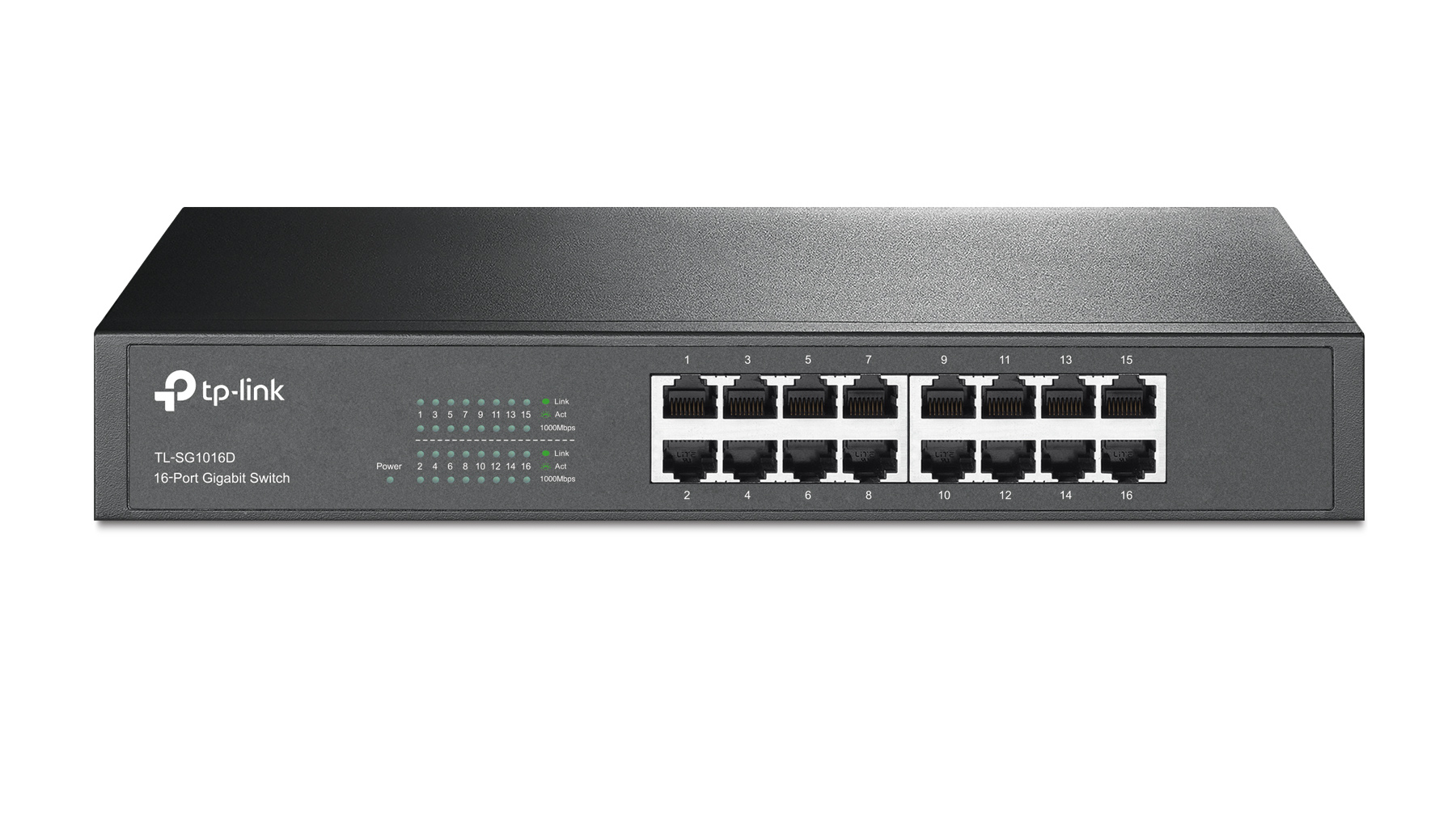TP-Link TL-SG1016D 16-Port Unmanaged Gigabit Switch
A trusted model that now represents a reliable budget buy


Whether as the nerve centre for a home overflowing with gadgets, or the hub of a small office, this set-and-forget switch offers excellent value, even after 7 years
-
+
Rack mountable; Zero config; Lots of explanatory LEDs
-
-
Lacks PoE; No management function at all
Usually, when we review a product, we're looking for the latest, greatest devices that do something that was hitherto unavailable.
In the case of an unmanaged switch, however, so little has changed in terms of the underlying technology that it doesn't age. The clue is in the name - unmanaged - there's nothing to configure and nothing to go wrong; in theory, it should just work.
And so, after seven years, the TL-SG1016D has hit our desk once again, with nothing changed save for sporting a newer TP-Link logo. But at under 50 excluding VAT, it's now a significant bargain, at less than half the price of equivalent models from other brands.
The key spec is that all 16 ports are gigabit (10/100/1000). With many other models, particularly then but to a lesser extent now, a couple of ports will give full speed, while the others languish at a more modest 10/100.
For the average user, if deployed correctly, it won't make a huge difference, but if the rest of your network can take advantage of the extra throughput, you'll notice a significant difference to the speed between, say a user's computer and a NAS device, which can often be a severe bottleneck.
All ports also offer MDI/MDIX negotiation. This means that whether you have CAT 5, CAT 5e or CAT 6 ethernet cables, the switch will work out the correct speed and traffic flow for you. Of course, again, your choice of cable will affect the performance of the network, but unless you've got some very creaky old CAT 5 cables in your network, you will feel the benefit.
As well as adjusting the speed, the switch can also correct the power throughput, meaning that the amount being consumed is significantly less than if all 16 were going hell for leather. This would matter more if Power over Ethernet (PoE) were supported, which it isn't, but it still matters. The whole system runs cool enough to be fanless anyway, which offers an additional saving in terms of cost to run.
Traffic management is offered with IEEE 802.3x flow control for full duplex and back pressure for half duplex and a total 32Gbits/sec switching capacity and 10KB Jumbo Frame Store and Forward transferring. There's also MAC address self-learning and auto-aging for added security.
What you don't get is pretty simple. You can't control access to individual ports by MAC address or time, you can't limit throughput to manually control speeds and as we've discussed, you can't power anything as there's no PoE.However, you can choose to have everything done for you in the most efficient way possible, and either put it on a shelf, or rack-mount it with the enclosed kit.
The indicators on the front show what each port is doing according to activity, and with multiple lights to show whether it has negotiated a 10/100 or 1000 (gigabit) connection.For a system that clocks in at less than many 8-port switches, there's a lot to recommend the TL-SG1016D. For the small to medium business that wants something that 'just works', it's ideal. If your infrastructure is aging, this represents a very cost effective way of improving throughput on the network. And with the proliferation of stuff from the Internet of Things, home power users will find it ideal as a way of managing traffic on struggling home networks.
With Gigabit Ethernet still not close to reaching the end of its usefulness, there's little to suggest that this won't do what you need from it for many years to come, and like many of the best devices, do it in a way that allows you to forget it's even there.
Verdict
Whether as the nerve centre for a home overflowing with gadgets, or the hub of a small office, this set-and-forget switch offers excellent value, even after 7 years
| Size | 294 x 180 x 44 mm |
| Maximum Power Consumption | 9.26W |
| Packet Forwarding Rate | 23.8Mpps |
| MAC Address Table | 8K |
| Jumbo Frame | 10KB |
| Standards and Protocols | IEEE 802.3i, IEEE 802.3u, IEEE 802.3ab , IEEE 802.3x |
| Interface | 16 10/100/1000Mbps RJ45 Ports (Auto Negotiation/Auto MDI/MDIX) |
| Network Media | 10BASE-T: UTP category 3, 4, 5 cable (maximum 100m)100BASE-TX/1000BASE-T: UTP category 5, 5e or above cable (maximum 100m) |
Get the ITPro daily newsletter
Sign up today and you will receive a free copy of our Future Focus 2025 report - the leading guidance on AI, cybersecurity and other IT challenges as per 700+ senior executives
Chris Merriman has been writing about technology since the 1990s for a variety of titles including Computer Shopper, MSN, TechRadar, Tom’s Guide and The Inquirer, where he broke a number of major tech news stories that were picked up globally. He has appeared on BBC, Sky News and Al Jazeera and was the resident tech expert at TalkRadio for a number of years. In between times, he has also been a consultant for several major tech firms.
Chris is fascinated by automation and the internet of things, as well as the evolution of the ways we communicate in the digital era. He's also a frequent contributor to ITPro's software guides, including Windows operating systems. Other specialisms include storage, peripherals, and web apps, and any gadget he’s allowed to take apart and fiddle with, preferably after throwing away the box, manual and receipt.
-
 Cleo attack victim list grows as Hertz confirms customer data stolen – and security experts say it won't be the last
Cleo attack victim list grows as Hertz confirms customer data stolen – and security experts say it won't be the lastNews Hertz has confirmed it suffered a data breach as a result of the Cleo zero-day vulnerability in late 2024, with the car rental giant warning that customer data was stolen.
By Ross Kelly Published
-
 Women show more team spirit when it comes to cybersecurity, yet they're still missing out on opportunities
Women show more team spirit when it comes to cybersecurity, yet they're still missing out on opportunitiesNews While they're more likely to believe that responsibility should be shared, women are less likely to get the necessary training
By Emma Woollacott Published
-
 OpenAI wants developers using its new GPT-4.1 models – but how do they compare to Claude and Gemini on coding tasks?
OpenAI wants developers using its new GPT-4.1 models – but how do they compare to Claude and Gemini on coding tasks?News OpenAI says its GPT-4.1 model family offers sizable improvements for coding, but tests show competitors still outperform it in key areas.
By Ross Kelly Published